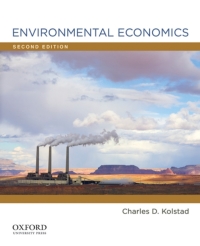Consider the problem of carbon dioxide emissions. We will abstract away from the problem slightly, assuming there
Question:
Consider the problem of carbon dioxide emissions. We will abstract away from the problem slightly, assuming there are polluters and consumers in two regions, the \(\mathrm{OECD}(\mathrm{O})\) and the rest of the world (R). Suppose the marginal cost of controlling \(\mathrm{CO}_{2}\) emissions is \(\$ 10\) per ton of emissions. Let the marginal willingness to pay for pollution reduction be \(13-Q\) for region \(O\) and \(12-2 Q\) for region \(R\), where \(Q\) is the amount of pollution reduction. The United Nations is considering two proposed methods for controlling \(\mathrm{CO}_{2}\) emissions, both involving polluters paying for the damage they cause. Proposal A involves the polluters paying damages to each region for the pollution generated. Proposal B involves the polluters in each region independently negotiating pollution reductions, assuming the other region is not undertaking pollution reduction.
a. Graph the marginal abatement cost and the total marginal willingness-to-pay schedules. What is the socially efficient level of emission reductions, \(Q\) ?
b. How much total pollution reduction will occur under proposal \(\mathrm{A}\) and what will be the total compensation received by regions \(\mathrm{O}\) and \(\mathrm{R}\) ? If those payments were instead placed in the general coffers of the UN, would the outcome be any different from an efficiency point of view? Why or why not?
c. How much pollution would be generated under proposal B? Explain any differences between this answer and the answer to parts (a) and (b).
Step by Step Answer:






